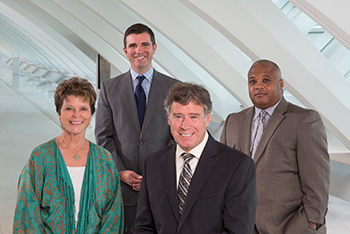
This year’s top legal innovators meet at the Milwaukee Art Museum. From left: Susan Hansen, David Simon, Norman Gahn, and Stanley Davis. Photo: Andy Manis
Imagine. A serial rapist has terrorized your community for several months, even, possibly, years. There are multiple victims, but no clues as to the rapist’s identification, only his DNA. The statute of limitation for prosecuting these crimes is running out, and you desperately want to get this guy off the streets. You get a crazy idea … and it works!
That’s innovation.
For the second year, the State Bar of Wisconsin is honoring Wisconsin’s legal innovators. Earlier this year, the State Bar asked the legal community to help it tell the story of legal innovation.
“While some in the legal community look at the changing legal marketplace as a looming crisis,” says Tom Watson, who chairs the Communications Committee’s Innovations Subcommittee, “others see an environment ripe for new ways of providing legal services.”

Know a legal innovator? Are you one? Watch for the call for next year’s nominations in spring 2016. To learn more, visit ThatsaFineIdea.com.
“Through the ‘That’s a Fine Idea: Legal Innovation Wisconsin’ initiative, we’re looking for risk takers, visionaries in the legal profession who found creative ways to solve client or community problems, drive internal operating efficiencies, or transform office culture to ensure it thrives tomorrow,” says Watson.
“’Impressive’ – that’s how I’d sum up this year’s innovators,” he says. “And, along the way, we discovered a lifetime innovator who is long overdue for recognition of the impact he has had prosecuting sexual assault cases and other crimes in Wisconsin.”
“We hope these examples of innovations spawn additional creativity, which positions Wisconsin’s legal profession to thrive in an evolving and competitive marketplace,” adds Watson.
Here you will meet nine colleagues: the lifetime award winner, three top legal innovators, and five other noteworthy examples (see sidebar, “On Our Radar: Five More Fine Ideas”).
Know a legal innovator? The call for next year’s nominations will run from April through June 2016. Learn more at ThatsaFineIdea.com.
Lifetime Innovator Norman Gahn: DNA Pioneer
Rodney Washington raped five teenage girls in Milwaukee in the mid 1990s, but he fled to Illinois before he could be identified, caught, and convicted. It became a cold case, with the statute of limitation set to expire in 2001.
By then, Norman Gahn, a Milwaukee County assistant district attorney, had struck on a new idea for using DNA evidence. In 1999, he issued the county’s first John Doe DNA arrest warrant in a sexual assault.
The warrant didn’t specify an individual by name, but by DNA profile. “It was a legal maneuver to keep a case open after the expiration of the statute of limitation,” Gahn explains.
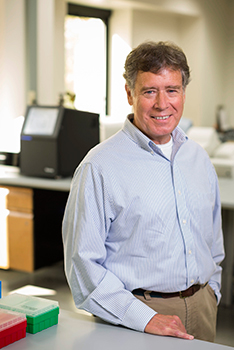
Norman Gahn, shown here at the U.W. Biotechnology Center, issued Milwaukee County’s first John Doe DNA arrest warrant in a sexual assault to keep a case open after the statute of limitation expired. His pioneering work in courtroom use of DNA evidence earned him national recognition. Now, he’s the recipient of the State Bar’s first-ever Lifetime Legal Innovator Award. Photo: Andy Manis
Meanwhile, Washington had committed another rape and armed robbery in Illinois, after which he landed in prison. Upon his release in 2007, authorities took DNA swabs and entered them into the DNA data bank, according to the Illinois practice at that time of taking swabs at release rather than entrance into prison.
That’s when the Milwaukee County DA’s office got a hit for the rapes of the five teenagers and eventually won a conviction against Washington. By then, the victims were in their late 20s.
“They looked at me,” Gahn recalls, “and told me they were so grateful we went to the trouble to put some kind of legal closure to this god-awful searing event from their past.”
Gahn’s pioneering work in courtroom use of DNA evidence has won him awards from the FBI and the National Institute of Justice. Then last April, Attorney General Eric Holder presented him with the Allied Professional Award at the National Crime Victims’ Service Awards Ceremony in Washington, D.C.
And now Gahn adds yet another award to his collection. He’s the recipient of the State Bar’s first-ever Lifetime Legal Innovator Award.
Gahn’s results with John Doe warrants have led to changes in laws. Wisconsin has eliminated the statute of limitation for sexual assaults, thus removing the need for John Doe warrants. Other states have followed suit.
Another innovative way Gahn has used DNA evidence is to keep some rapists in prison beyond their scheduled releases. In those instances, DNA evidence linked a prisoner to other sexual assaults, besides those that resulted in incarceration, for which the statute of limitation had expired.
“I couldn’t charge that person,” Gahn explains, “but I could put together information for the parole board to let them know he’d raped other women, too.”
Gahn retired in June after 31 years as an assistant district attorney working on sexual assault and homicide cases. That job was his first after earning his law degree at Marquette University Law School in 1984. Before that he served 10 years in the U.S. Army as a military police officer and as a field office commander with the Army’s Criminal Investigation Division.
During his Army years, he obtained a master’s degree in forensic science from George Washington University, with plans to pursue a military career.
“Then I thought I’d take the LSAT to see how I’d do,” he recalls. “While I was a military police officer and with the Criminal Investigation Division, I’d been to crime scenes and testified in court. I saw that the judge advocates liked what they were doing. I knew I wanted to be a prosecutor.”
Now that he’s retired, Gahn is glad to be away from the barrage of gut-wrenching cases he dealt with daily. Still, he looks back on a satisfying career. “I liked working with the crime scene analysts,” he says, “and putting a case together using all this science and technology. I thought, ‘This is why I went to law school.’”
U.W. Law School’s Black Law Students and Latino Law Students Associations: Calming Influence
Emotions ran high last March after a Madison police officer shot and killed Tony Robinson, a biracial, unarmed 19-year-old man. Protesters gathered, and high school students walked out of classes – as many as 50 percent at one local school.
Members of the U.W. Law School’s Black Law Students Association and Latino Law Students Association felt they needed to do something to avert the sort of violence that erupted after similar incidents elsewhere.

The U.W. Law School’s Black Law Students and Latino Law Students associations created a video to avert violence from erupting after a Madison police officer shot and killed a biracial, unarmed man. Participating students include (from left): Keyon Brown, Qortney McLeod, Jasmine Trimble, Aissa Olivarez, and Jared Prado. Adjunct law school professor Stanley Davis spearheaded the students’ efforts. Photo: Andy Manis
“We thought there was a legitimate role for the law school to serve as a neutral source of information,” says Stanley Davis, an adjunct law school professor who spearheaded the students’ efforts to produce a 14-minute video, “Understanding Police Use of Deadly Force.”
The students worked diligently – even through final exams – to complete the video in approximately six weeks.
They released it at a press conference with Mayor Paul Soglin on May 11, the day before Dane County District Attorney Ismael Ozanne was to announce his decision whether to bring charges against the officer.
In the video, the students explain clearly how such decisions are made, how police are trained regarding use of deadly force, and why Wisconsin has a law requiring an independent investigation into these incidents.
“With all the emotions going on,” Davis says, “we wanted to make sure people had a solid understanding of what was taking place.”
Also during finals week, just before the video’s release, the students gave a live presentation at a community summit. Davis recalls watching the audience, including many of high-school age.
“These kids were sitting there completely transfixed by what the law students were saying,” he says. “What was cool about it was that these kids could see their potential future. They saw these law students who looked like them, sounded like them, and came from the same places they did. That’s why it was important to engage the black and Latino law students in the video.”
webXtra
<iframe src="//www.youtube.com/embed/68yf3xouXc8?rel=0&autohide=1" width="300" height="169" frameborder="0" allowfullscreen></iframe>
“Understanding Police Use of Deadly Force,” by U.W. Law School’s Black Law Students Association and Latino Law Students Association, produced by WHA Public Television, winner of a State Bar of Wisconsin 2015 Legal Innovator Award.
Students who worked on and appeared in the video included Lola Bovell, Keyon Brown, Qortney McLeod, Aissa Olivarez, Jared Prado, and Jasmine Trimble. Professors who advised the students were Ben Kempinen, Cecelia Klingele, Mary Prosser, Ion Meyn, and Stacy Taeuber. WHA Public Television produced the video at no cost. Harold Rayford, bishop of Madison’s African American Council of Churches, helped publicize the video. And the Wisconsin Professional Police Association posted the video on its Facebook page.
In the end, Ozanne chose not to charge the officer. Many disagreed with that decision, but no violence or destruction erupted in Madison. Says Davis, “We hope we had at least a little to do with that.”
David Simon and John Turlais: Business Problem Solvers
In today’s global economy, U.S. companies of all sizes are selling their products and services abroad. To help them do that in compliance with the law, David Simon and John Turlais of Foley & Lardner LLP in Milwaukee have devised a new tool.
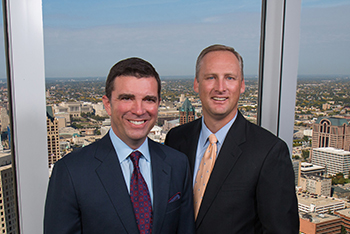
David Simon (left) and John Turlais of Foley & Lardner LLP, Milwaukee, devised a new tool to help U.S. companies comply with the Foreign Corrupt Practices Act when doing business abroad. The tool, Foley Global Risk Solutions, helps clients implement the legal advice dispensed to help them follow the law. Photo: Scott Patrick
All these companies must comply with the Foreign Corrupt Practices Act (FCPA), which prohibits the payment of anything of value to a government official or employee of a state-owned commercial enterprise in order to influence that person or obtain or retain business.
The U.S. Department of Justice and the U.S. Securities & Exchange Commission (SEC) have made FCPA enforcement a top priority. Violations can be costly due to fines and reputation damage. A recent enforcement against Smith & Wesson was “a wake-up call for small and mid-sized companies,” as the SEC head described it, that they’re under scrutiny just like the big companies.
Simon and Turlais have worked in FCPA law for years. They saw that Fortune 50 companies could afford to hire FCPA legal advice or set up in-house compliance departments. But small and mid-sized companies often didn’t get help. Or when they did, they didn’t always know what to do with it.
That’s a Fine Idea! Innovation Initiative Earns National Award
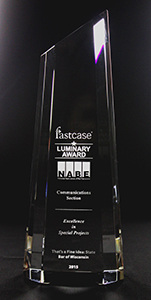 Members of Wisconsin’s legal community aren’t the only ones receiving awards for innovative projects. In September 2015, the National Association of Bar Executives (NABE) Communications Section presented the State Bar of Wisconsin with a 2015 Luminary Award for its “That’s a Fine Idea! Legal Innovation Wisconsin,” a project that showcases our state’s legal innovators.
Members of Wisconsin’s legal community aren’t the only ones receiving awards for innovative projects. In September 2015, the National Association of Bar Executives (NABE) Communications Section presented the State Bar of Wisconsin with a 2015 Luminary Award for its “That’s a Fine Idea! Legal Innovation Wisconsin,” a project that showcases our state’s legal innovators.
In presenting the award for Excellence in Special Projects at its annual meeting in Orlando, an evaluator said, “I love this idea. The stories are inspiring and compelling – and different from the same-old, same-old. That it was handled in a comprehensive way with not only print, but electronic and social media really worked. Great job!”
“There’s a lot of legal innovation going on in Wisconsin, and we’re excited to have a role in showcasing that creativity,” said Tom Watson, chair of the State Bar Communications Committee Innovations Subcommittee.
“I’d walk clients through what they needed to do to have an effective FCPA compliance program,” Simon says, “and they’d look at me and say, ‘I understand why this is important and what the risks are to my company. But I don’t know how to implement what you just told me.’”
Simon and Turlais had a flash of insight for a better approach. Typically lawyers advise and clients act on that advice. “But it hit us,” Simon says, “that maybe we could do more. Maybe we could build something that’s a plug-and-play sort of solution.”
They rolled out that technology as Foley Global Risk Solutions a few months ago. Clients subscribe to it for a flat annual fee, costing them less than traditional legal counseling. In return, they get several FCPA services:
a risk assessment;
training;
policies and procedures;
FAQs, news, and updates on FCPA;
technology-assisted legal advice using an app based on a complex algorithm incorporating questions and consequences of the answers; and
one-on-one follow-up consultation, which Simon and Turlais can provide more quickly and efficiently because they have the client’s information upfront.
With this tool, everything the client does to comply with the FCPA is documented. That can avert major repercussions if the company undergoes investigation.
“We solve a real business problem for our clients,” Simon says, “instead of just advising them on what they need to do to follow the law.”
Susan Hansen and Greg Hildebrand: Reducing Divorce Conflict
All too often, divorce ends with two angry people who are barely speaking to each other, children caught in the parental crossfire, and financial strains for one or both ex-spouses. And, also too often, the couple ends up back in court post-judgment to continue the battle.
Milwaukee attorneys Susan Hansen and Greg Hildebrand aim to offer a remedy to such scenarios through the Family Mediation Center.
“We think this concept resonates with couples who want a lower-conflict, lower-cost, healthier process for separation and divorce,” Hansen says.
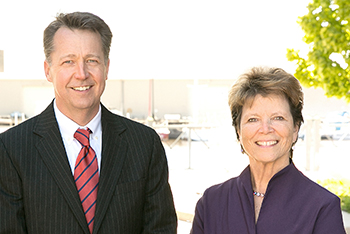
Greg Hildebrand and Susan Hansen created the Family Mediation Center to help divorcing couples who want a lower-conflict, lower-cost, healthier process for separation and divorce. After an initial meeting with a neutral lawyer mediator who explains the legal steps, various divorce process options, and the legal issues to be resolved, clients may seek additional, individualized mediation help from a group of independent contractors.
By coming to the Family Mediation Center, she explains, couples learn there’s a choice between navigating through a divorce with no legal help – as 70 percent of divorcing couples do – and working with two lawyers in an adversarial process.
At the center, new clients sit down with a neutral lawyer mediator who thoroughly explains the legal steps, the various divorce process options, and the legal issues that will need to be resolved. The flat fee for the initial session is $250.
From there, the couple may seek additional mediation help from one or more professionals with expertise in child psychology, budgeting, tax planning, and business evaluation. These services are on an as-needed basis to fit the clients’ circumstances.
The center works closely with a core group of independent contractors who provide those added services. “Our goal is to offer an individualized approach for clients,” Hansen says, “but to have consistency in our process.”
The Family Mediation Center opened in spring 2015 as the Milwaukee Mediation Center. “What happened quite quickly,” Hansen explains, “was that some judges, court commissioners, and therapists in areas surrounding Milwaukee were very interested. They said it would be good to have additional sites and a name that wasn’t so Milwaukee-centric.”
Dianne Molvig is a frequent contributor to area and national publications.
Thus, the new name came into existence this summer, and two additional mediation sites opened in Mequon and Waukesha.
Clients represent a cross-section of the community, according to Hansen, from lower income to middle income to fairly affluent. In the case of some couples, one or both own a private business. They see the value of working together with guidance from a neutral mediator instead of in a court battle, which, Hansen points out, can be destructive to both the couple and the business.
For couples with children, “Our goal is to have them view divorce as restructuring the family, rather than ending the family,” Hansen says. “It’s incredibly hard work to create a co-parenting relationship at the same time that you’re ending a marriage. And yet, for parents who care deeply about their children, it’s the most important work they can do.”
On Our Radar: Five More Fine Ideas
Innovation – big or small – means that the profession is proactively adapting to today’s competitive environment. Here are five additional noteworthy stories about Wisconsin lawyers who set about to make change.
Jennifer Binkley / Community Justice Inc.: Representing Domestic Abuse Victims
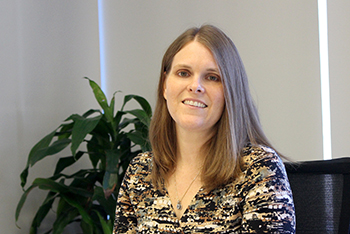 More than 25 percent of the calls for help coming into Community Justice Inc. (CJI) in Madison involve issues of domestic violence. CJI provides affordable legal services to low- and middle-income people in South Central Wisconsin.
More than 25 percent of the calls for help coming into Community Justice Inc. (CJI) in Madison involve issues of domestic violence. CJI provides affordable legal services to low- and middle-income people in South Central Wisconsin.
In the past, when domestic violence victims called into CJI, “We wanted to help them,” says Jennifer Binkley, managing attorney and development director. “But even with our significantly reduced fees, it was impossible for many people.”
Nearly 29,000 domestic abuse incidents were reported in Wisconsin in 2013. According to the Wisconsin Department of Justice, one-third of those victims live in Dane or Milwaukee County. In many cases, lack of money is an enormous obstacle to pursuing legal action.
CJI struck on a solution to this unmet legal need by obtaining various grants to cover the costs for domestic violence cases. Now CJI attorneys are able to represent clients at restraining order hearings for free, three times per month. In some cases, grant money also goes toward fees for additional legal representation.
Typically, referrals come from Domestic Abuse Intervention Services (DAIS). CJI partners with Quarles & Brady’s legal clinic and U.W. law professor Marsha Mansfield and the law school’s Family Court Clinic to handle those referrals. Quarles & Brady also pitches in to pay for outside translator services, when needed.
“By working cooperatively,” Binkley says, “we’re trying to make sure that every single referral that comes from DAIS asking for legal representation on a restraining order gets coverage by an attorney in Dane County.”
Bill Caraher / von Briesen & Roper S.C.: An inGenious Idea for Law Firm Training
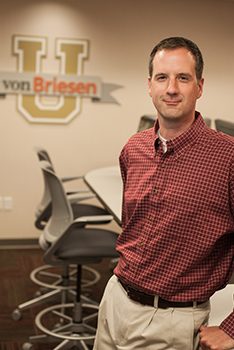 Mention of a law firm training room is likely to evoke an image of a space filled with rows of chairs and tables topped with computers, and someone at the front of the room explaining how to use a new piece of software or some other topic.
Mention of a law firm training room is likely to evoke an image of a space filled with rows of chairs and tables topped with computers, and someone at the front of the room explaining how to use a new piece of software or some other topic.
Bill Caraher, chief information officer at von Briesen & Roper S.C., Milwaukee, decided to create a better way.
“I thought, where do people like to experience technology? What do they think is cool? It hit me that they go to the Apple Store to see what’s new, get hands-on experience, and ask questions,” Caraher says.
Thus, the Apple Store became the model for the inGenious Bar, a bright, colorful space where attorneys and staff can drop in to get a five-minute, one-on-one training session with technology staff.
The inGenious Bar opens for 90 minutes every Friday and presents a pre-announced topic for the day. That might be how to send a secure email, or what’s a home drive and why it’s needed, among scores of other topics.
Five minutes may not seem like much, but that adds up to four hours of non-CLE training a year, Caraher points out, which attorneys typically balk at doing.
“Firms struggle to get attorneys to sit in a class,” Caraher says. “They don’t have that hour or half-hour. But they can take a few minutes to grab a cup of coffee, get in, and get out.”
The inGenious Bar has been operating for about a year. “People keep coming back,” Caraher says. “That’s a testament to the fact that they are getting value out of it.”
Photo: Mark Hines
Robert Barrington / Dodge County District Attorney’s Office: Accessing Electronic Files Anytime
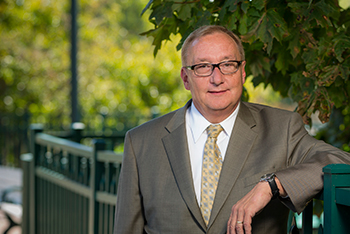 “Where in blazes is that file?”
“Where in blazes is that file?”
That’s a question not heard in years in the Dodge County District Attorney’s office, thanks to an electronic filing system developed by Robert Barrington, managing attorney.
Barrington used PROTECT, the state’s record management system provided to all county DA offices, to devise his electronic filing system, which went live in-house in mid 2010. Thanks to this system, Dodge County DAs have access to any file at any time, from anywhere with an Internet connection. They can even use the file when someone else is using it.
Thus, when CCAP and DA IT (District Attorney Information Technology) decided to develop electronic filing for criminal cases, they looked to Dodge County as the logical choice for a pilot project launched in early 2015.
“We had already worked through a lot regarding how to handle electronic files in an office,” Barrington says. “So we’re able to provide input that’s been helpful to the entire court system.”
Criminal case e-filing saves time and paper shuffling. “It enables a lot of efficiencies not only in the DA’s office, but also in the clerk’s office,” Barrington says. CCAP and DA IT now are identifying other counties that are ready to implement the system.
“This is the final link,” Barrington says. “We get our referrals through an e-referral interface, so there’s no paper coming to us from the sheriff’s department. Then we process everything internally without any paper. And now we finally can interface with the courts without using paper. It’s a seamless, paperless system from the cop on the street to the filing in the court.”
Photo: Andy Manis
Diane Rondini-Harness / State Public Defender’s Office: Stemming the School-to-Prison Pipeline
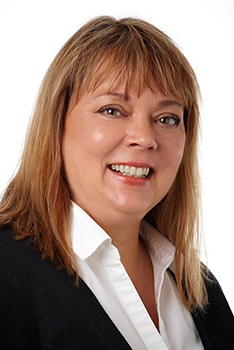 School expulsion or suspension often starts a journey to nowhere. Students fall behind, slip into truancy, drop out of school … and may land in trouble in the juvenile or criminal justice system.
School expulsion or suspension often starts a journey to nowhere. Students fall behind, slip into truancy, drop out of school … and may land in trouble in the juvenile or criminal justice system.
This pathway is known as the “school-to-prison pipeline,” says Diane Rondini-Harness of the State Public Defender’s Office (SPD). Yet, students typically have no legal representation at expulsion hearings.
At a juvenile justice conference, Rondini-Harness and several colleagues were inspired to do something about this problem. And met to brainstorm. “We literally wrote out our idea on a cocktail napkin,” she says. Committee members who provided expertise include Catherine Dorl (agency leadership), Gina Pruski (training development), Devon Lee and Eileen Fredericks (juvenile law), Richard Jones and Matthew Giesfeldt (expulsion law), and Evan Nordgren and Puck Tsai (infrastructure).
The result is the Student Expulsion and Prevention Project (StEPP). The SPD has no jurisdiction to represent students in expulsion hearings. So StEPP teaches volunteer attorneys how to do it. The training covers the nuts and bolts of expulsions, adolescent brain development, child interview techniques, and cultural awareness.
With the help of a State Bar Pro Bono Initiative Grant, StEPP did its first training in January 2015. A refresher session and production of an instructional video resulted in a pool of 40-some trained lawyer volunteers who receive free CLE credits if they handle at least one case within a year.
Since StEPP’s pilot project began in the Madison Metropolitan School District, volunteers have represented six students in expulsion hearings. Three weren’t expelled, and the others were expelled for less time than the district initially sought.
StEPP is now expanding to all Dane County school districts and hopes eventually to reach other parts of Wisconsin. Says Rondini-Harness, “We’re certainly looking for other lawyers who want to participate.”
Brynne McBride / ABC for Health: Guiding Through the Health Care Coverage Maze
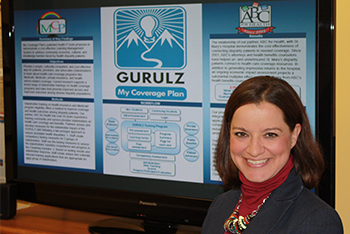 Trying to decipher health care coverage programs is sure to trigger eyes-glazed-over moments. ABC for Health’s mission is to make it all easier to understand. Now the Madison-based public interest law firm is working on a new solution to achieve that goal.
Trying to decipher health care coverage programs is sure to trigger eyes-glazed-over moments. ABC for Health’s mission is to make it all easier to understand. Now the Madison-based public interest law firm is working on a new solution to achieve that goal.
It’s called GURULZ (read that as “gu-rules”), a play on the fact that some describe ABC for Health as the guru of health care coverage rules, explains Brynne McBride, chief operating officer and project director for the organization’s HealthWatch Wisconsin project.
ABC for Health already had created a training portal to teach health care advocates, hospital personnel, and others about the intricacies of various coverage programs. The trainees are people who counsel health care consumers and steer them to suitable coverage.
Improved knowledge of health care coverage can spare consumers from medical debt burdens and chip away at huge losses health care providers incur for uncompensated care. That amounted to $1.3 billion for 2014, says the Wisconsin Hospital
Association.
With the older training portal, “We’d created a ‘garage-built’ version,” McBride explains, “but it’s kind of clunky. We saw a need to take that to the next level.”
Hence the development of GURULZ, which is targeted to go live sometime in 2016. McBride describes it as a “learning management system.” The trainee logs into the system, which has the person’s profile and information on training videos already completed. It suggests other videos the user might find useful.
Compared to the garage-built version, “It’s more user-friendly and individualized,” McBride says. “It gets people down the path to figuring out the landscape of health care coverage.”
